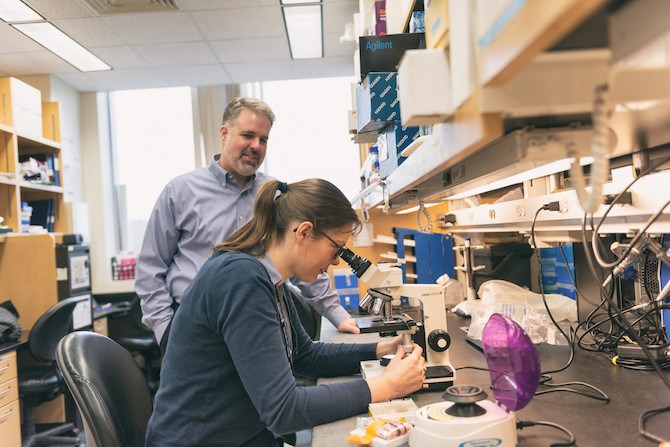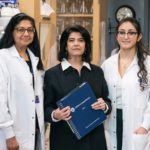Drug repurposing and DNA mining: The hunt for new endometriosis treatments

Endometriosis is a common gynecological condition that may affect more than 1 in 10 reproductive-age women. Yet, there’s very little research into the disease and limited options for treatment. A team in the Vascular Biology Program at Boston Children’s Hospital is trying to change that.
In endometriosis, tissue that normally grows inside the uterus grows outside of it, usually in other places in the abdominal cavity, like the ovaries and intestines. These growths can be asymptomatic, with women unaware they even have endometriosis, but they can also cause life-altering infertility and pain.

The current mainstays of treatment — surgery to remove lesions and hormonal medication — both come with their own flaws.
Surgery can restore fertility, but doesn’t always relieve pain, and most women will need repeat operations over time. Nonsteroidal anti-inflammatory drugs (NSAIDs), like aspirin and ibuprofen can help with pain relief, but don’t work for everyone. Hormonal medications, such as continuous birth control pills and GNRH agonists and antagonists, also don’t work for everyone and have side effects. GNRH agonist therapy can be “like putting a 17-year-old girl into menopause,” says Michael Rogers, PhD, who is leading the search for new treatments.
Replicating endometriosis pain
Rogers, along with his research fellows Daniëlle Peterse, PhD, and Victor Fattori, a PhD student, have developed a new mouse model of endometriosis that more accurately represents the human experience. The mice even show pain similarly to humans, rubbing their abdomens against the ground to relieve their discomfort much as we might rub an aching body part. “Our model is most similar to what women experience in terms of pain,” says Fattori.

The scientists are using their new model to test a series of drugs already used for other conditions to see if any might help with endometriosis pain. Through review of the scientific literature and consultation with other researchers, they’ve identified drug categories that endometriosis might plausibly respond to, including drugs that prevent angiogenesis (the creation of new blood vessels) and anti-inflammatory drugs. So far, tests have confirmed that the mice respond similarly to humans to existing medications, and have already found one promising new candidate drug. The team hopes to be able to follow up on this candidate and continue identifying new ones.
Seeking clues in DNA
In addition to trying to repurpose existing drugs, the team is also hunting through the DNA of endometriosis lesions for clues to creating new drugs. While other studies have identified mutations in lesions that burrow deep within the tissue, and in endometriomas, cysts on the ovaries, the Rogers lab is seeking mutations in superficial lesions, the most common type. Once the team identifies mutations, they can use the gene editing tool CRISPR to find possible drug targets for treating the diseased tissue.
The existing mutation already makes the cells of the lesions more vulnerable. With CRISPR, the team can introduce a second mutation to disable all the other proteins in the cell one by one. Their goal is to find a gene (and protein) that, if disabled, will incapacitate the already vulnerable, mutated cells, but will have no effect on more stable, normal cells.
“The initial mutation is like a broken right leg,” says Rogers, “and we’re going to try breaking all the bones to find which no longer allows the mutated cell to walk.”
Because this is such an understudied disease, we have a lot of opportunity to better understand it.
They could then make a drug that targets this protein. Ideally, that drug would reduce pain with minimal side effects.
Faster diagnosis?
There’s frequently a long gap between experiencing the first symptoms of endometriosis, which often appear in adolescence, and receiving a diagnosis. Even in the relatively wealthy, hospital-filled Boston area, the gap averages nine years. Women are often referred to gastroenterologists and even psychiatrists in the meantime.
Ultimately, identifying the mutations could not only help with medication development, but also potentially lead to a new diagnostic tool. Currently, receiving a diagnosis involves surgery so “many people won’t go in to get it diagnosed,” Peterse says. A simpler, less invasive diagnostic tool could shorten the time to diagnosis and allow more women to receive treatment.
Endometriosis research receives very little government funding – less than $10 million and falling – so donors are powerfully placed to have a major impact. There is also little preexisting research and few current research groups working on it. “Because this is such an understudied disease, we have a lot of opportunity to better understand it,” says Rogers.
Related Posts :
-

The clot thickens: Kellie Machlus, PhD
Part of an ongoing series profiling researchers at Boston Children’s Hospital. Platelets are the bandages of our blood, forming ...
-

Going out of the box to tackle pancreatic cancer
Pancreatic cancers are deadly and hard to treat, in part because they are so often detected at an advanced stage; ...
-

Obesity is increasing people’s risk of cancer. Why?
Obesity is now a global epidemic, and it is increasing people’s risk for cancer. The National Cancer Institute lists ...
-

Could concussion be monitored through urine samples?
Concussion can be frustratingly hard to diagnose and track. The injury doesn’t show up on routine brain scans, and ...





